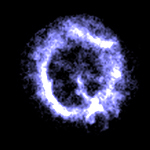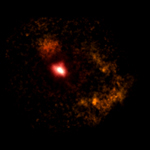September 20, 1999
CXC PR: 99-05
Images from NASA's Chandra X-ray Observatory released today reveal previously unobserved features in the remnants of three different supernova explosions. Two of the remnants G21.5-0.9 and PSR 0540-69 show dramatic details of the prodigious production of energetic particles by a rapidly rotating, highly magnetized neutron star, as well as the enormous shell structures produced by the explosions. The image of the third remnant, E0102-72, reveals puzzling spoke-like structures in its interior.
G21.5-0.9, in the constellation of Scutum, is about 16,000 light years (1 light year = 6 trillion miles) from Earth. Chandra's image shows a bright nebula surrounded by a much larger diffuse cloud. Inside the inner nebula is a bright central source that is thought to be a rapidly rotating highly magnetized neutron star. A rotating neutron star acts like a powerful generator, creating intense electric voltages that accelerate electrons to speeds close to the speed of light. The total output of this generator is greater than a thousand suns. The fluffy appearance of the central nebula is thought to be due to magnetic field lines which constrain the motions of the high-energy electrons.
"It's a remarkable image," said Dr. Patrick Slane of the Harvard-Smithsonian Center for Astrophysics. "Neither the inner core nor the outer shell has ever been seen before."
"It is as though we have a set of Russian dolls, with structures embedded within structures," said Professor Gordon Garmire of Penn State University, and principal investigator of the Advanced CCD Imaging Spectrometer, the X-ray camera that was used to make two of the images.
NASA's project scientist, Dr. Martin Weisskopf of the Marshall Space Flight Center said, "Chandra's capability to provide surprises and insights continues."
The existence of a rotating neutron star, or pulsar, in the center of G21.5-0.9 is inferred from the appearance of the nebula and the energy distribution of X-rays and radio waves from the nebula. This distribution, called non-thermal radiation is characteristic of radiation produced by high-energy electrons in a magnetic field.
A previously known pulsar is observed directly in the Chandra image of PSR 0540-69. This pulsar, located in a satellite galaxy to the Milky Way that is 180,000 light years distant, emits pulses of radio, optical, and X radiation at a rate of 50 per sec. These pulses which come from a neutron star rotating at this incredible rate, comprise only a few percent of the total energy output of the neutron star powerhouse.
"The Chandra image gives us a much better idea of how this energy source works," said Dr. Stephen Murray, principal investigator for the High Resolution Camera, the X-ray camera used to make PSR 0540-69 image. "You can see X-ray jets blasting out from the pulsar in both directions."
The third Chandra supernova image is E0102-72. Located in the Small Magellanic Cloud, another satellite galaxy of the Milky Way, E0102-72 is 190,000 light years from Earth. This object, like G21.5-0.9 and PSR 0540-69, is believed to have resulted from the explosion of a massive star several thousand years ago. Stretching across 40 light years of space, the multi-million degree source resembles a flaming cosmic wheel.
"Chandra's gallery of supernova remnants is giving us a lot to think about," said Dr. Fred Seward, of Harvard-Smithsonian, who with his colleagues discovered E0102-72 and PSR 0540-69 with the Einstein Observatory over a decade ago. "We're seeing many things we thought should be there, and many others that we never expected. It's great!"
To follow Chandra's progress, visit the Chandra News Web site at:
NASA's Marshall Space Flight Center in Huntsville, Alabama, manages the Chandra X-ray Observatory for NASA's Office of Space Science, NASA Headquarters, Washington, D.C. The Smithsonian Astrophysical Observatory's Chandra X-ray Center in Cambridge, Mass., manages the Chandra science program and controls the observatory for NASA. TRW Space and Electronics Group of Redondo Beach, Calif., leads the contractor team that built Chandra.
High resolution digital versions of the X-ray image (300 dpi JPG, TIFF) and other information associated with this release are available on the Internet at:
An animation of a supernova explosion and the formation of a supernova remnant can be found at:
NASA TV on the web
MEDIA CONTACTS
Dr. Wallace Tucker
Chandra X-ray Observatory Center
Harvard-Smithsonian Center for Astrophysics, Cambridge, MA
Phone: 617-496-7998
http://chandra.harvard.edu
Tim Tyson
Marshall Space Flight Center, Huntsville, AL
Phone: 256-544-0994
http://www.nasa.gov/centers/marshall/news




